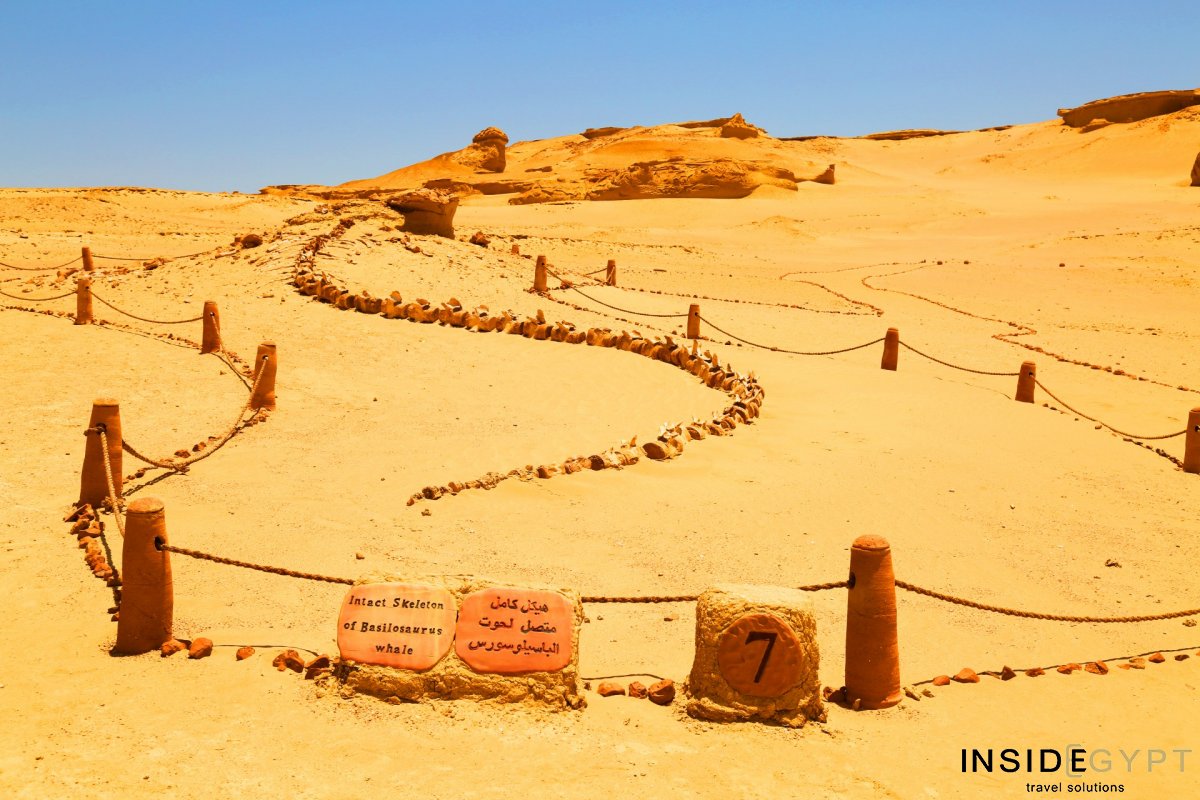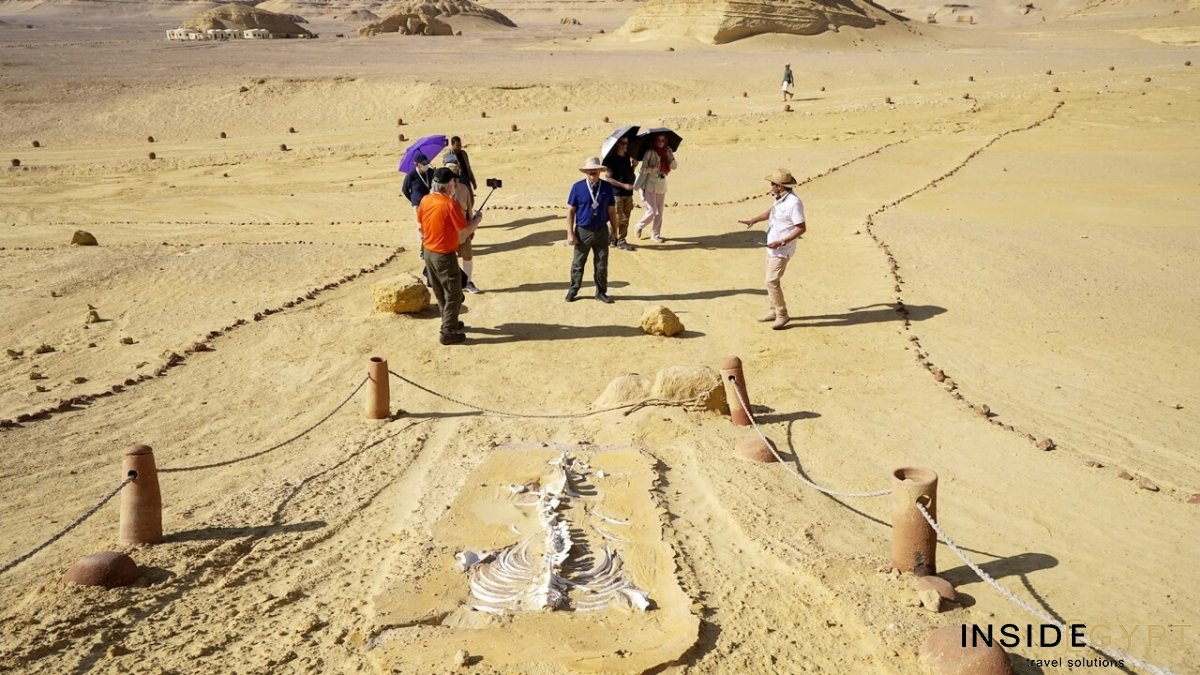Stay updated!
The Valley of the Whales, known as Wadi Hitan, is a UNESCO World Heritage Site and one of Egypt's most extraordinary natural wonders. This remarkable location is famous for its fossilized whale skeletons, which provide a fascinating glimpse into Earth's evolutionary history.
These fossils showcase the transition of ancient whales from land-dwelling creatures to marine life, highlighting the evolution of species in our planet's past. Wadi Hitan is often referred to as "whale valley" due to its significant paleontological discoveries, making it an essential destination for anyone interested in the history of life on Earth.
Inside Egypt offers exclusive, high-end tours that immerse visitors in the unique geological and paleontological significance of Wadi Hitan. During these guided experiences, travelers can explore the remarkable landscape and learn about the incredible walking whales of Egypt that once thrived in this area.
The Valley of the Whales is notably featured in the 14 Days in Egypt Tour offered by Inside Egypt. For those joining the 10-Day Tour of Egypt or the 8-Day Egypt Tour, a 1-day add-on for the standard arrival day (day 1) is available, allowing participants to experience the wonders of Wadi Hitan. This opportunity ensures that visitors can discover the incredible history and natural beauty of this UNESCO site.
Let your adventure in Egypt begin! Book your Egypt group tour!
Photos of the Desert Whales and Wadi Hitan






















Discover Our Exclusive Egypt Tours
Tour Reviews
FAQ About the Valley of the Whales in Egypt
What is Wadi Al Hitan?
Wadi Hitan, also known as the Valley of the Whales in Egypt, is a geological marvel and a paleontological site of global importance. This extraordinary valley is renowned for its abundance of well-preserved fossils, particularly the remains of ancient whales that once roamed the Earth millions of years ago. Designated as a UNESCO World Heritage Site, the findings in this valley play a crucial role in understanding the ecological changes that have occurred over millions of years.
In Wadi el Hitan there is also the Fossil and Climate Change Museum, which opened in 2016. The displays of fossils and information boards within this circular one-room museum do an excellent job of explaining the geological history, nature, and the role of climate change in this area. The displays all surround the museum's crowning exhibit, an 18-meter long skeleton of a Basilosaurus Isis whale.
Egypt's Whales Valley is a unique destination that attracts scientists, researchers, and tourists alike. The site features not only the fossilized remains of various whale species, but also a striking landscape that enhances the overall experience of visitors. Walking through this valley of fossilized whales, you can truly appreciate the significance of this ancient ecosystem and its contributions to our understanding of marine evolution. As one of the world's most important paleontological sites, Wadi Hitan and the Whale Valley continue to captivate and educate those who seek to learn about our planet's history and the remarkable journey of life on Earth.
How did the whale skeletons end up in the desert?
The Valley of the Whales offers a remarkable glimpse into Earth's past, illustrating how whale skeletons came to be preserved in the desert. Millions of years ago, during the Eocene Epoch, this region was part of a vast shallow sea teeming with marine life. Ancient whales inhabited these waters, and as they succumbed to natural causes, their bodies settled into the sea floor, becoming part of the sedimentary layers.
Over time, significant geological and environmental changes transformed this once-thriving marine ecosystem into the arid desert we see today. Tectonic activity shifted the Earth's plates, causing the sea to recede and ultimately leading to the exposure of the whale skeletons in the desert. As the climate became increasingly dry, the sedimentation that had preserved these remains solidified into rock. The combination of shifting landscapes and enduring aridity created the ideal conditions for preserving the fossilized remains in astonishing detail.
Today, the desert whales serve as a fascinating testament to the region's ancient history, providing invaluable insight into the evolution of whales and offering a unique opportunity for paleontological study. The extraordinary fossils found in Wadi al Hitan continue to captivate scientists and visitors alike, showcasing the incredible journey of life and the environmental changes that have shaped our planet over millions of years.
Why are they called “the walking whales” of Egypt?
The fossilized remains found in Wadi Hitan, often referred to as the "walking whales" of Egypt, hold immense evolutionary significance in understanding the transition of mammals from land to sea. These remarkable fossils showcase a unique blend of characteristics that illustrate this critical evolutionary shift. Dating back approximately 40 million years, these ancient cetaceans exhibit transitional features, including vestigial limbs that highlight their gradual adaptation to aquatic life.
The walking whales possess small, paddle-like forelimbs, which serve as a testament to their ancestry on land while indicating their move towards a fully marine existence. These vestigial structures reflect a fascinating evolutionary experimentation as these creatures adapted to their changing environment. In addition to their limbs, the fossils also reveal adaptations such as elongated bodies and streamlined shapes, which are essential for life in water.
The Whale Valley of Egypt is considered a treasure trove in the Whale Valley of Egypt, as it provides crucial evidence of the evolutionary history of the marine mammal. The fossils found here not only deepen our understanding of anatomical changes but also highlight how these ancient species bridged the gap between terrestrial and marine ecosystems. The walking whales of Egypt remind us of the dynamic nature of evolution, showcasing the intricate pathways life has taken on Earth through millions of years of adaptation and change.
Where is the Valley of the Whales located?
Wadi Hitan is a fascinating paleontological site located in Egypt's Western Desert, within the Fayoum Oasis region. Situated approximately 150 kilometers (93 miles) southwest of Cairo, this UNESCO World Heritage site is renowned for its fossilized whale skeletons found in the desert.
To reach Wadi Hitan and the Valley of the Whales, visitors can start by renting a car in Cairo and driving to the Fayoum region. Once in Fayoum, it is essential to rent a jeep for access to the remote site. Alternatively, joining an organized tour from Cairo is the most convenient option, as it provides transportation and guides who enhance the experience with their insights about the area.
The allure of Wadi Hitan lies not only in its rich archeological significance but also in its isolation amidst the vast desert landscape. As you approach Whale Valley, the rugged terrain and serene surroundings create a profound sense of wonder. Exploring the site, visitors can marvel at the well-preserved fossilized remains set against an awe-inspiring backdrop, making it a unique destination for those interested in natural history and geology. Wadi Hitan serves as a striking reminder of the Earth's evolutionary past, inviting exploration and reflection in a stunning desert oasis.
What is the best way to visit the Valley of the Whales?
The best time to visit the Valley of the Whales in Egypt is during late autumn, winter, or early spring when temperatures are milder, making for a more pleasant experience. It's advisable to start your trip early in the morning, as the journey from Cairo takes around three hours each way.
When planning your visit, opting for a guided tour not only simplifies the logistics but also enriches your visit with expert knowledge.
Inside Egypt offers exclusive tours that include a visit to the Valley of Whales. Our 14 Days in Egypt Tour incorporates Wadi Hitan as a highlight. For those opting for shorter tours, such as the 10-Day or 8-Day Egypt Tours, a one-day add-on is available, allowing participants to experience the incredible wonders of this UNESCO World Heritage site.
Discover Our Exclusive Egypt Tours
Inside Egypt tour packages offer an exceptional opportunity to immerse yourself in the rich history and vibrant culture of Egypt while exploring breathtaking sites such as Wadi Hitan, home to the "walking whales."
Our exclusive packages are:
17 Days in Egypt on a Long Nile Cruise
15-Day Egypt Tour with Siwa Oasis
14 Days in Egypt Tour, featuring an unforgettable visit to the Whale Valley
12-Day Red Sea Tour
10-Day Tour of Egypt, with an optional trip to Wadi Hitan
8-Day Egypt Tour, including an optional trip to Wadi Hitan
7-Day Egypt Total Solar Eclipse Tour
Inside Egypt stands out for offering personalized and upscale experiences, accommodating only 20 travelers per group. Enjoy luxurious stays in top-tier, 5-star hotels and savor creatively curated cuisine at distinctive restaurants. Spacious, comfortable buses enhance your travel experience, with dedicated tour leaders available 24/7 for personalized support.
Each tour is designed not just for sightseeing, but to foster camaraderie among like-minded travelers, creating bonds through shared exploration. With VIP access to iconic sites, including the Giza Plateau and the Great Pyramid, you'll leave with a profound understanding of Egypt's captivating history.
Places are limited, so book your exclusive journey today!
What People Say About Our Whale Valley Tours
Inside Egypt's guided experiences at the Valley of the Whales offer travelers an unforgettable journey, blending natural beauty with deep insights into Egypt's ancient history. Visitors often express their amazement at the unique fossils and the stunning desert landscape, enhancing their appreciation for this remarkable site.
"A fascinating place with the remains of whales that are several million years old scattered throughout the desert." Kevin Hahn
"This experience surpassed my expectations! We switched to a 4x4 vehicle to reach the Valley, driving through the expansive desert, which was breathtakingly beautiful. After the bustling atmosphere of Cairo, the tranquility of the desert was remarkable. The views are stunning, and it's incredible how well-preserved the whale bones are. We visited in March 2024, and the temperature was already climbing, so be prepared! There's a small but informative museum and a restaurant offering delicious Bedouin-style food—those tomatoes have a surprising kick! You could easily spend all day here exploring, but I recommend around 1,5-2 hours for a satisfying visit." Faye Caldwell
"A unique destination that combines outdoor fossils, the informative Fossil and Climate Change Museum, stunning landscapes, and glimpses into Egyptian Bedouin culture." Mary Brown
Inside Egypt provides enriching experiences that connect guests with the natural and cultural wonders of the Valley of the Whales, making for a truly memorable adventure.
Other Sites Nearby
While Wadi Hitan is a stunning destination showcasing the ancient "walking whales of Egypt," there are several nearby attractions that enrich the experience of exploring the Fayoum region. Here are some notable sites to visit:
Fayoum Oasis
Known for its lush landscapes and agricultural heritage, Fayoum Oasis is a picturesque region that offers a delightful contrast to the surrounding desert. Visitors can explore traditional villages, sample local cuisine, and enjoy scenic views of the natural environment.
Wadi El Rayan Waterfalls
This stunning natural attraction is a beautiful oasis that features two large lakes and a series of cascading waterfalls. Ideal for picnics and photography, Wadi El Rayan is also a habitat for many wildlife species, making it a serene spot for nature lovers.
Qasr Qarun Temple (Qarun Palace)
Dating back to the Ptolemaic period, this ancient temple is dedicated to the crocodile god Sobek. The site showcases fascinating ruins and inscriptions that reveal the architectural prowess of ancient Egyptians. It's a must-see for history enthusiasts.
The Magic Lake
This striking lake is characterized by its unique blue waters and picturesque surroundings. It is a fantastic spot for relaxation and photography, offering breathtaking views of the sunset over the water.
These sites, along with Wadi Hitan, create the perfect itinerary for a complete Egyptian adventure. Exploring beyond Wadi Hitan allows visitors to appreciate the diverse natural beauty and rich historical tapestry of the Fayoum region, making for an unforgettable journey through Egypt.



